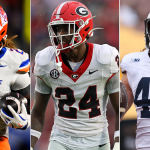Mississippi State head baseball coach Gary Henderson said on a phone call Thursday that White Sox third-round pick and Mississippi State ace Konnor Pilkington has all the tools to be a successful professional baseball player.
“He can create all the pitches that need to be created with me or his next pitching coach in the pen,” Henderson said.
Henderson Pilkington’s growth may take some time, but he is confident he will get there. Besides the fact that coaches know their players better than anyone, Henderson draws on decades of coaching some of the most elite pitching talents in the country to formulate his conclusions.
Pilkington checks a lot of boxes for the White Sox. He was ranked as the No. 60 prospect by MLB.com and stirred up a fair amount of interest leading into the 2018 season as a few publications speculated he could become a top-10 pick. “We were very excited to have the opportunity to take him and add a premium starter like this in the third round,” White Sox director of scouting Nick Hostetler said.
After speaking with Henderson, it appears the White Sox stole the southpaw in the third round. According to Henderson, Pilkington isn’t going to blow the doors off of hitters (he will show low to mid-90s stuff early and settle in around 89-92), instead, he will carve you up with fastball command and speed changes. Fastball command is the strength that Henderson hailed most in our conversation.
Strengths
“Elite fastball command for about the first six weeks this year,” said Henderson.
Pilkington’s pinpoint accuracy tapered off over the season and Henderson speculates that an erosion to average accuracy and lack of a stifling secondary pitch contributed to his fall in draft status. But by no means does he feel Pilkington has peaked. If anything, he sees plenty of room for development in the secondary pitches to compliment his surgical command.
So how accurate was Pilkington early in the season? “Goofy numbers,” Henderson said. “Near [Casey] Mize numbers.” Through Pilkington’s first six starts he logged 35 2/3 innings and only gave up four free passes. He faced good teams over that stretch as well including Louisiana, UC Santa Barbara, Southern Miss, Vanderbilt and Missouri.
Henderson added that he led the SEC in called third strikes and that that is “all about fastball command for him. … He can switch sides of the plate late in the count and guys are looking at it. And if the umpire gives him more than a ball in [or] off the plate it’s a tough pitch for the hitter.”
The intangibles are big-league grade with Pilkington. He is tall and lanky with a solid trunk that has allowed his delivery to stabilize. He was more wiry in high school but has packed on serious core strength while maintaining the loose nature of his delivery. A post-season Cape Cod Baseball League all-league nod in 2016 and strong performance with Team USA in 2017 elevated his stock leading into 2018. Most importantly, Henderson noted his “off-the-charts” makeup.
“He’s a country kid,” said Henderson. “Ultra-responsible. Off-the-charts accountable. As good as anyone I’ve worked with.”
Henderson explained that Pilkington is an excuseless player. He doesn’t blame the mound, the umpire, the wind or the stars for his failures.
“None of the BS,” Henderson continued, “which serves him really well because when you start blaming other people or other things you don’t change. You accept responsibility for what you’re doing, and you start getting right into making adjustments.”
Developmental Targets
Henderson did not demure from sharing that his ace southpaw is battling through a rough patch at the moment.
“I’d say his last seven starts, five times he’s had rough rhythm in the first inning,” Henderson noted. “Just one of those stretches.”
The skipper added that early exits are a function of high pitch counts more than anything else. He explained that it’s not uncommon for Pilkington to have a 30-pitch first inning and last through the sixth, but he’s been beaten up a bit recently.
Part of this issue according to Henderson, and something that is likely to be a target for revision with White-Sox coaching staff, is the rhythm in his delivery. This isn’t an uncommon problem with pitchers. Sometimes it takes an inning or two to get the feel for the moving parts of the delivery from day to day. It’s a constant tug-and-pull to strike the balance between not overburdening oneself in the bullpen before the game and getting to the point where players feel like they’re in sync.
In fact, translating stuff from bullpen to the game is something Henderson highlighted as well. He shared that occasionally Pilkington demonstrates great life on his two-seamer and changeup in the pen but becomes muted when he reaches the game.
Run on his two-seam fastball was an area that Henderson thinks Pilkington can add dimension to his dominance. He also added that his curveball and changeup will need some work. Henderson said Pilkington’s curveball has more slider action to it than 12-6 depth and consistency will be a point of emphasis for this pitch as well as his changeup.
Strangely, Pilkington’s statistics regressed each year in college with his earned run average peaking at 2.08 as a freshman in 2016. Henderson rationalized this as evidence of a weekend starter the last two seasons.
This season, the southpaw logged a career-worst 4.61 ERA but has demonstrated maturity in the face of adversity. Pilkington hurled 108 innings in 2017 in 17 starts while posting a 3.08 ERA holding opposing lineups to a .199 batting average. His unusual statistical pattern may have caused several teams to pass on Pilkington in the first two rounds.
And if you want irony and tested mettle, Pilkington has well seasoned when it comes to anemic run-support as Henderson noted his team struggled to push runs across for the ace early in the season. This is something we all know White Sox pitchers must battle from time to time.












